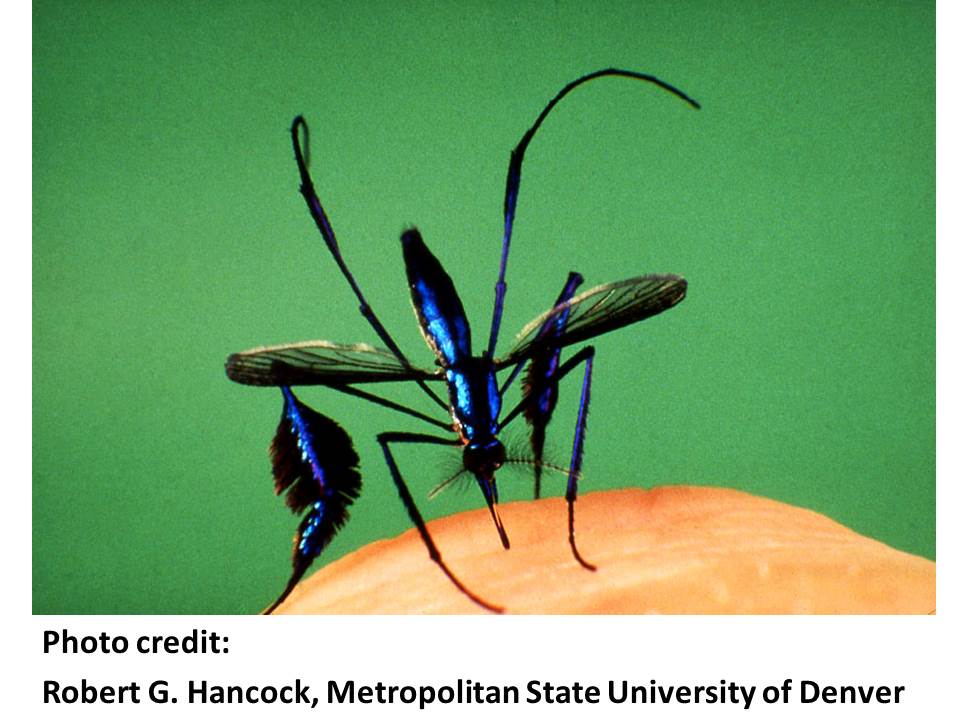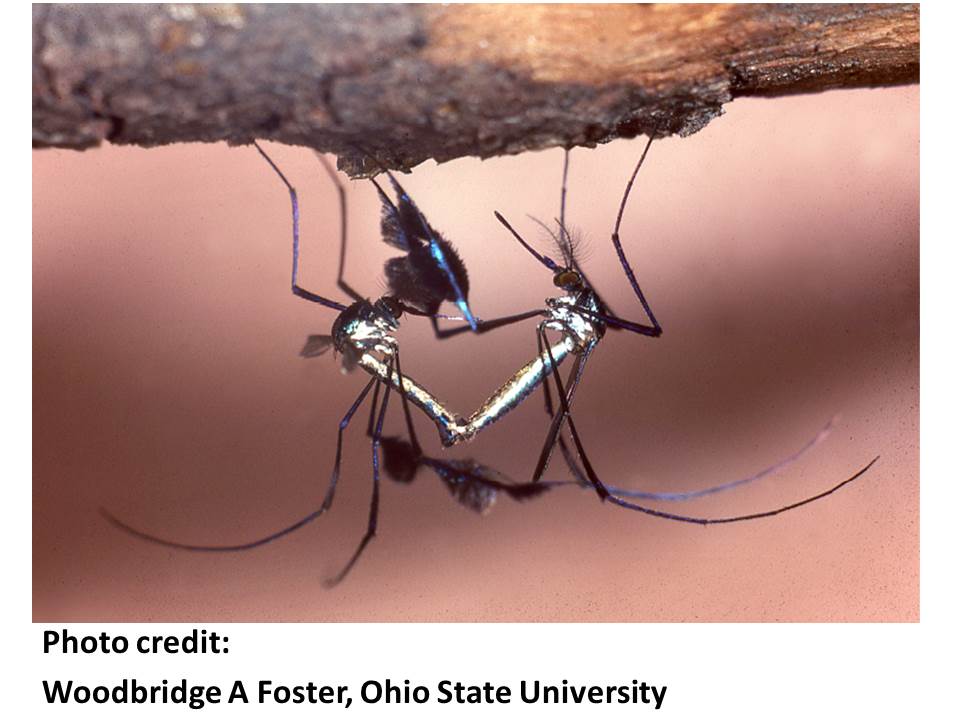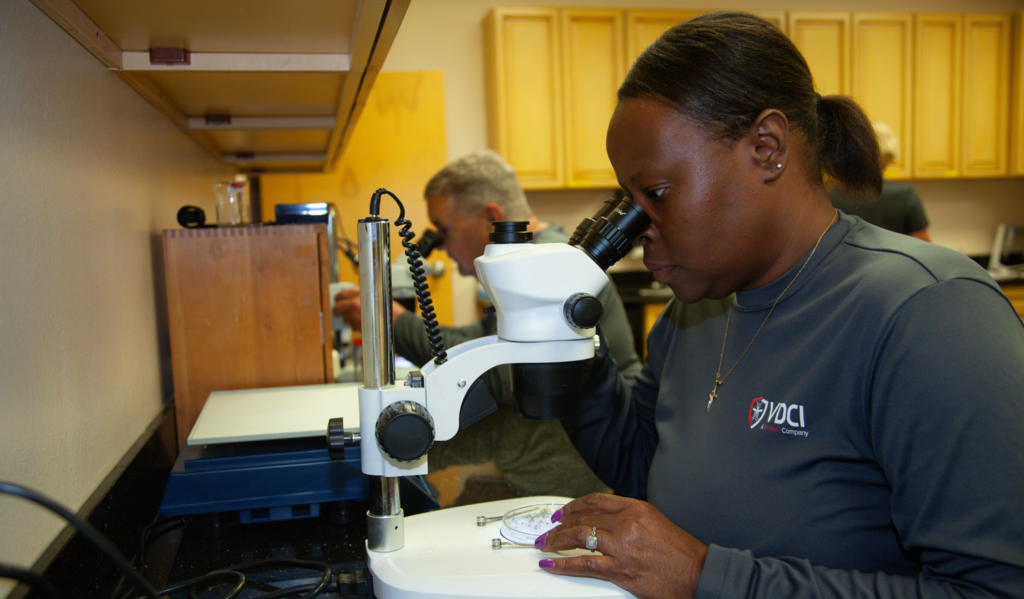Exploring Unique Mosquito Species
Valentine’s season is upon us — whether we like it or not, our obsession with courtship seems to take center stage. Indoor creatures, like humans, are not deterred by the winter; but, for most insects in the Northern Hemisphere, it is still too cold outside for mating. Meanwhile, in the tropics, many species are active throughout the year. Outside of a geeky entomology laboratory, it is quite rare for a discussion about courtship to include any mention of mosquitoes; the vast majority of species don’t display any behavioral patterns complex enough to even qualify for the term. For most mosquitoes, mating is a fast and haphazard occurrence with swarms of males circling around and waiting for the sound of female wing-beats. Once detected, the male rushes after the female and immediately attempts copulation mid-air without so much as a “how do you do?” – this is not courtship.
 There is one notable exception, the paddle-legged beauty, Sabethes cyaneus. This tropical forest species lay their eggs in shaded natural and artificial containers such as tree-holes, bamboo hollows, and even fallen banana leaves filled with rainwater. Sabethes larvae develop in these small source pools and feed on bacteria, algae, and other organic material. The beautiful adult Sabethes mosquitoes are usually encountered in close proximity to the small habitats of their youth.
There is one notable exception, the paddle-legged beauty, Sabethes cyaneus. This tropical forest species lay their eggs in shaded natural and artificial containers such as tree-holes, bamboo hollows, and even fallen banana leaves filled with rainwater. Sabethes larvae develop in these small source pools and feed on bacteria, algae, and other organic material. The beautiful adult Sabethes mosquitoes are usually encountered in close proximity to the small habitats of their youth.
Few people would use the words “beautiful” and “mosquito” in the same sentence, but Sabethes cyaneus has few rivals when it comes to looks. Its color is predominantly a stunning iridescent blue, marked with contrasting silvery-white spots – especially, on the abdomen (Wow!). Bold colors are not their only unique feature; the feather-like paddles catch the eye as well. Formed by elongated scales, located on the tibia of each middle leg, both the male and female sport these strange paddles. The function of the paddles is not fully understood; however, in the late 1980s, Dr. Robert Hancock and his colleagues observed mating behaviors that may lead to a better understanding.
WARNING: The following paragraphs contain graphic descriptions of mosquito courtship behavior – parental discretion is advised.
 Dr. Hancock’s team described the unique and elaborate series of stereotypical behaviors displayed by Sabethes mosquitoes prior to and during mating. Although dinner and dancing is not required as part of the ritual, the males must go through a number of displays and movements, in a specific order, and the female has multiple opportunities to accept or reject his advances.
Dr. Hancock’s team described the unique and elaborate series of stereotypical behaviors displayed by Sabethes mosquitoes prior to and during mating. Although dinner and dancing is not required as part of the ritual, the males must go through a number of displays and movements, in a specific order, and the female has multiple opportunities to accept or reject his advances.
The wooing begins with the female resting on the underside of a horizontal surface, such as a stick or twig. The male, apparently attracted by her stunning beauty, hovers around the female with his leg paddles outstretched. He then places one of these middle legs (midlegs) over her wing, perhaps preventing her from just flying away, but also to be used as a pivot point as he swings around to face his date and simultaneously grasps the twig with his front legs. Once aligned, the true courtship begins. The male waves his free midleg back and forth, apparently showing off his lovely paddle, but eliciting no apparent response from the female. Next, the male will flex his forelegs to create a bout of rhythmic body “swinging” while simultaneously flicking his proboscis (tube-like mouthpart) downward. If successful, this display will induce the female to lower her abdomen sufficiently for copulation to take place. If unsuccessful, he would return to waving his free midleg, followed by another round of rhythmic body swinging, until she either lowers her abdomen or uses her hind legs to reject him by pushing him away. During copulation, the male gyrates his abdomen while waving his middle and hind legs alternately until mating is completed and the pair disengages (Whew!). Lots of effort, compared to other mosquito species and most other animals.
So, in regards to mating, how important are those feather-like paddles? Hancock and his colleagues did some experiments to find out, removing the paddles and observing the results. If removed from the female, the males rarely approached. Apparently, for females, the paddles serve to attract the males. However, if the paddles were removed from the male legs, the males approached females to court with the same levels of success. What specific functions these paddles serve on the males remains unknown.
The snow is falling outside my window, as I write this, making me wish that I was in the tropical habitat of the Sabethes cyaneus. Then, I could observe this beautiful mosquito and its unusual courtship behaviors first-hand. For most of the over 3,000 species of mosquitoes identified, hardly anything is known about their biology and behavior. Perhaps there are other unusual stories of mosquito courtship waiting to be discovered in a tropical forest.

An important component of any successful Integrated Mosquito Management program is mosquito identification. Should you have any questions regarding mosquito identification, Vector Disease Control International (VDCI) is always available at whatever level of assistance you desire.
Contact Us to Learn More About Effective Mosquito Management Strategies:
 Since 1992, Vector Disease Control International (VDCI) has taken pride in providing municipalities, mosquito abatement districts, industrial sites, planned communities, homeowners associations, and golf courses with the tools they need to run effective mosquito control programs. We are determined to protect the public health of the communities in which we operate. Our mosquito control professionals have over 100 years of combined experience in the field of public health, specifically vector disease control. We strive to provide the most effective and scientifically sound mosquito surveillance and control programs possible based on an Integrated Mosquito Management approach recommended by the American Mosquito Control Association (AMCA) and Centers for Disease Control and Prevention (CDC). VDCI is the only company in the country that can manage all aspects of an integrated mosquito management program, from surveillance to disease testing to aerial application in emergency situations.
Since 1992, Vector Disease Control International (VDCI) has taken pride in providing municipalities, mosquito abatement districts, industrial sites, planned communities, homeowners associations, and golf courses with the tools they need to run effective mosquito control programs. We are determined to protect the public health of the communities in which we operate. Our mosquito control professionals have over 100 years of combined experience in the field of public health, specifically vector disease control. We strive to provide the most effective and scientifically sound mosquito surveillance and control programs possible based on an Integrated Mosquito Management approach recommended by the American Mosquito Control Association (AMCA) and Centers for Disease Control and Prevention (CDC). VDCI is the only company in the country that can manage all aspects of an integrated mosquito management program, from surveillance to disease testing to aerial application in emergency situations.

